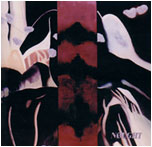


from us through PayPal.
Nøught's debut album is the outcome of a three year attempt to pin down an enormously diverse body of work that encompasses bold innovations in guitar based music and tethers them to various orchestral arrangements. While the live Nøught experience is genuinely about kicking down the boundaries accepted as rock music, the studio has allowed the group, an instrumental power trio, to express its vision on different terms. To this end, you will find strings, brass and woodwind but also less conventional media such as sitar, zitherharp, powerdrill and an array of domestic implements, complementing the already full-bodied sound.
The album opens with The Fans, in which we hear a lone guitar beckon the other players into melding a recognisable structure, which sets to music the regrets and resentments of an atheist evangelist as he rails against the church on his deathbed. As his grievances build-up before he meets his maker, so do the instruments and his non-verbal diatribe paves the way for the tone of the ensuing 50 minutes.
Nøught I is the first piece of music that the band wrote and is the signature tune to every performance it has played. A call to arms, it started off as a twenty-minute epic but has now become the band's second shortest song at one minute and fifty three seconds. The shortest is its sister companion piece, Nøught II, at one minute and forty one seconds. The third and final Nøught piece however, Nøught III, not on the album, is the beginning of a completely different twenty-minute epic.
Cough Cap Kitty Cat is the most frequently played Nøught song on the radio and was the band's first single. This newly recorded version details the elation of a gesticulating mute as he robs a well to do inebriate, who has dropped off to sleep in transit, of an expensive Stetson hat on a nightbus from
On an entirely different theme, Redrag, a paean to soul-destroying warehouse work typifying the despair drudgery provokes, was the band's second single and remains a live favourite. Another newly recorded version, the bassline required so many retakes that the usually very placid recording engineer, at the end of his tether, begged the band to leave it as it was, because he feared the volume necessary to achieve the desired tone would wreak irreparable structural damage to his studio. His pleas fell on deaf ears!
Goddess Awakes, a trilogy, charts the getaway from a bloodbath intended to have been the last big bank heist of a down-at-heel felon. Part I, The Tricks Of Strangers, describes his escape from inner city to docklands, pausing briefly to hide out in a disused warehouse where he reflects on his life of violent crime, only to realise that his 'shot at the big time' was in fact a set-up by those who would wish him out of the picture. With no hope in sight and the police closing in, he steals a speedboat in a last ditch attempt to escape doing time. Pursued as far as
Stain Stones recalls days of heady mischief in
All The Time Ha-Ha! is a "brief laugh-tale" about a lifestyle for those in the know, an unending and ever increasing state of intense hilarity. A condition not shared by the horn section which took eleven days to fulfil its obligations on what was temporarily dubbed "The Impossible."
As the title suggests, Heart Stops Twice charts the terminal progress of an inveterate alcoholic who is ordered by a bowl of soup to pinch his wife's last savings, escape the hum-drum of his life and embark on a colossal drinking binge. This he does with his friends in his local bar, only for them to turn on him and beat him up and kick him out when the coffers run dry. At this point cardiac arrest ensues and while he is unconscious, thieves rifle his pockets for anything of worth. On waking he discovers that not only is he penniless, but has also let himself go and he spends the day begging for a lifesaving drink. Finally, bereft of luck or hope and wheezing, the heaviest breezeblock in history crashes down on his chest, cramming the remainder of his life into a massive second and fatal coronary on a park bench. As we leave his frozen body, his wife ponders what hour of the night he'll decide to drag himself back.
After the brevity and vigour of Nøught II, Ignatius chooses to alert us to the evil that men do to others and themselves. Its central character is a sad man vying for popularity and spreading his own myth, eulogising himself as a legendary hellraiser. His efforts to impress by swift exits in taxis from drawn out and depraved encounters fall on stony ground and his acquaintances turn their backs for good. He vows to avenge himself the only way he knows how. By daubing his pseudonym and what was tantamount to "something he had been toying with for quite sometime" in gaudy red paint on the living room wall of the house of the girlfriend he had driven into an asylum, he inaugurates a lengthy period of anomie. However, due to the small-time nature of his endeavours he rapidly create a semi-permanent kingdom of one before being bundled into official exile via the tradesman's entrance. The day that he left did not weigh heavily on our consciences to say the least. Towards the end of the piece the sounds of bells ringing out represent the celebrations at the end of the conflict between Ignatius and our kind. The twenty guitar chorus that is the climax of both this piece and indeed the album heralds the sound of better days arriving.
